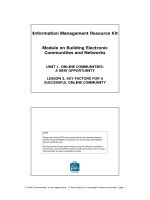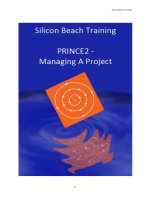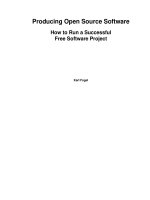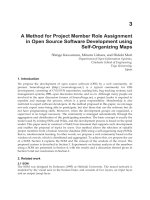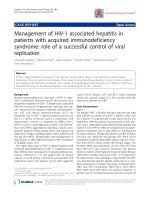Assignment 1 1625 Managing a Successful Computing Project Greenwich 2022
Bạn đang xem bản rút gọn của tài liệu. Xem và tải ngay bản đầy đủ của tài liệu tại đây (1.21 MB, 18 trang )
ASSIGNMENT 1 FRONT SHEET
Qualification
BTEC Level 5 HND Diploma in Computing
Unit number and title
Unit 06: Managing a Successful Computing Project
Submission date
29/10/2022
Date Received 1st submission
29/10/2022
Re-submission Date
01/11/2022
Date Received 2nd submission
03/11/2022
Student Name
Nguyen Manh Tung
Student ID
GCH200064
Class
GCH0907
Assessor name
Nguyen The Lam Tung
Student declaration
I certify that the assignment submission is entirely my own work and I fully understand the consequences of plagiarism. I understand that
making a false declaration is a form of malpractice.
Student’s signature
Grading grid
P1
P2
P3
P4
M1
M2
D1
Summative Feedback:
Resubmission Feedback:
2.1
Grade:
IV Signature:
Assessor Signature:
Date:
Contents
Introduction ......................................................................................................................................................... 1
I.
II.
Project initialization ........................................................................................................................................ 1
1.
Main aim of project ......................................................................................................................................... 1
2.
List of Objectives to achieve the aim ............................................................................................................. 1
III.
Project management plan ............................................................................................................................... 2
1.
Scope ................................................................................................................................................................. 2
2.
Time .................................................................................................................................................................. 3
3.
Communication ............................................................................................................................................... 3
4.
Risks.................................................................................................................................................................. 4
5.
Resources.......................................................................................................................................................... 4
6.
Cost estimation ................................................................................................................................................ 4
Planning................................................................................................................................................................ 5
3
1.
WBS .................................................................................................................................................................. 5
2.
Gantt chart ....................................................................................................................................................... 6
Primary research .................................................................................................................................................... 7
4
1.
List of interview question................................................................................................................................ 7
2.
Summary about interview .............................................................................................................................. 8
3.
List of survey question .................................................................................................................................... 8
4.
Summary about survey ................................................................................................................................. 10
5.
Evaluation ...................................................................................................................................................... 10
Secondary research ........................................................................................................................................... 10
5
1.
List of articles/ books .................................................................................................................................... 11
2.
Summarize ..................................................................................................................................................... 11
3.
Evaluation ...................................................................................................................................................... 13
Figure 1: WBS ................................................................................................................................................................ 5
Figure 2: Gantt chart ..................................................................................................................................................... 6
Figure 3: Suvery question (1)......................................................................................................................................... 8
Figure 4: Survey question (2)......................................................................................................................................... 9
Figure 5: Survey question (3)......................................................................................................................................... 9
Figure 6: Survey question (4)......................................................................................................................................... 9
Figure 7: Survey question (5)....................................................................................................................................... 10
I.
Introduction
Problem: By 2025, the amount of data will reach 175ZB, which is a huge number. Imagine the computer
hard drive is only 1TB then the difference will be obvious. As data increases, the number of terminals such
as hard drives and phones also increases, which consumes a lot of power as well as resources, which is a
reason for environmental pollution. The main reason for the increase in data is that the old data is still stored
and the data that is not needed or is no longer useful is kept.
Solution: Stemming from the above reasons, the proposed solution will focus on the input data, process it
in real time, filter and store the necessary data, and delete the data that is no longer effective. To implement
this solution, AI and IoT are necessary tools. IoT will collect real-time information, process it first if it's not
too complicated, then send it back to the central processor, AI will decide what data is data back, what
actions are taken, etc.
Project: As a member of the research and development department of the National Hydrometeorological
Administration, I will be working on a project called "Climate Management AI".
With the characteristics of the meteorological industry, the data sent every day is very large such as rainfall,
air humidity, satellite images, tropical depressions, etc. The amount of data to be processed is very large, a
lot of data is not important or often encountered causing time consuming. Due to the large amount of data,
manual deletion takes a long time, possibly deleting important data by mistake. Large capacity leads to
greater power consumption to run. This project will integrate AI to solve the above problem.
II.
1.
2.
Project initialization
Main aim of project
Integrate data processing technology for the system.
Input data processing eliminates redundant data.
Reduce newly generated data.
Reduce the workload for employees.
More accurate prediction of phenomena.
Easy data statistics.
List of Objectives to achieve the aim
1. Learn about data types (work with data researchers)
1.1 Collect commonly sent weather data types.
1.2 Learn about their influence on the weather.
2. Learn similar systems (hospital applications, etc.)
2.1 Working with agencies using the system.
2.2 Find out advantages, disadvantages, points to note.
1
3. Understanding AI technology for systems (Machine learning)
4. Building AI for the system (data processing and weather forecasting system)
4.1 Requirements.
4.2 Analysis and design.
4.3 Deployment (Encoding).
4.4 Testing.
5. Evaluation.
5.1 Get a technical staff assessment.
5.2 Provide general assessment and reporting.
5.3 Provide direction for development.
III.
Project management plan
1. Scope
The "Climate Management AI" project will be completed within 3 months. This project is an AI
with functions such as collecting and processing weather data, cleaning up redundant data, it is
developed and applied to the current weather management system.
During the first week, we will analyze the feasibility, identify the risk and plan for it. The technology
applied will also be explored along with the study of the climate center's actual data. Finally, make
a specific plan for the whole project.
In the next 3 weeks, work related to building the system will be carried out, including user
requirements analysis (station staff), system design. We spent 2 weeks programming the system and
applying it to the existing system.
We spend the next 7 weeks testing in the climate center to be able to give the most accurate
assessments. In the last week, assessments will be taken from staff, experts who have used the
system, that information will be collected and written into a report along with the direction of
development.
Finally, we will hand over the project back to the climate center for use.
The aim of this project is to reduce the amount of data stored on a daily basis, use machine learning
to predict the weather, increase accuracy, and help with real-time processing.
-
A self-learning system.
2
- The system makes predictions on behalf of experts.
- Minimize the amount of input data.
2. Time
Phase
Plan
Description
Analyze goals, systems, technology to be used, feasibility
Risk plan
Learn similar systems
Research data of current system
Building final plan
Building AI
Run in actual
system
Evaluation
and closing
Get the request of the staff, experts at the center
Analysis requirement
Design system
Implement (coding)
Add to current system
Testing
Testing in system at center
Get feedback of staff
Evaluate
Write report
Development direction and hand over
3. Communication
Time
15/8 - 21/8/2022
1 day
1 day
1 day
3 days
1 day
21/8 - 19/9/2022
1 day
1 day
3 days
14 day
1 day
1 day
19/9 – 07/11/2022
Status
Done
07/11/2022 – 14/11/2022
1 day
3 days
2 days
1 day
Awating
Done
Processing
Our team will have face-to-face meetings and some online meetings with Google Meet. Daily reports
will be sent via chat group on Zalo.
Type
Daily
meeting
Daily Report
Analysis
(Plan)
Research
Data
Analysis
Requirement
Design
Implement
Testing
Frequency or
Purpose
times
3-5 times/week Reporting and implementing new tasks
Google Meet
Every day
3 times
Zalo
Offline
Daily progress report
Analyze problems to develop plans and
risk plans
3 times
Working with staffs, experts to
understand data
2 times
Segregate the task of taking user
requests and analyzing them
Every day (in 2 Building system
weeks)
Every day (14 Test system
days)
Method
Offline
Offline
Google Meet + Offline
Google Meet
3
Daily
test
system
Get
feedback
Evaluate
Handover
20-25 times/ 7 Test system and check work progress
weeks
1 times
Get feedback of user
3 times
1 times
Offline
Offline
Evaluate and write report of project
Offline
Handing over the system to the climate Offline
center leader
4. Risks
No
Name
1
Requirement
2
Not enough
people
3
Project
schedule
4
Technology
5
Cost
6
Many errors
Description
Infulence Consequence
level
Collect or evaluate user High
Depending on the
requirements,
wrong
stage that affects the
project purpose.
project differently, it
can affect the whole
project.
Temporary leave due to Low
Slow down the
illness or other causes
project progress.
(more than 2 people).
Important in-person
Low
Slow down the
meetings (possibly due to
progress.
weather).
The selected technology
Medium
Back to the planning
is not suitable for the
stage.
system
Types of costs incurred
Low
Lack of budget.
such as hiring experts,
buying equipment.
After actual testing, there
were more errors than
expected.
Medium
Fix bugs that slow
progress, waste
valuable time and
data.
Solution
Work with many experts to
understand, collect clear
requirements, seriously
analyze.
Find 2 replacement personnel
from the beginning of the
project
Prepare another temporary
replacement plan to avoid
delays.
Work with development
experts to understand, choose
the right technology.
Prepare a contingency budget
at the beginning of the project
(about 10-20% of the main
budget).
Detailed test planning.
5. Resources
Tools:
Upgrading system hardware (chips, heatsinks, etc.)
Google Meet, Zalo
Development tools for AI
Human:
5 persons: 1 senior, 3 junior AI, 1 tester.
6. Cost estimation
4
No Type
1
Salary
2
Detail
1 senior (3000$/month), 3 junior (1500$/month), tester
(1000$/month), time is 3 month.
Upgrade the system to be able to integrate AI technology.
Upgrading
system
hardware
3
Hire an
Hire experts to advise on technology, development direction
expert
4
Learn
Working on projects using similar technology
more
technology
5
Risks
The cost to deal with the risks if they arise, it is about 10% of
the total cost.
6
Total
3 Planning
1. WBS
Cost
25500$
25000$
1000$
500$
5000$
57000$
Figure 1: WBS
This WBS is divided into 4 phases: Planning, Building, Run the actual system, Evaluation and closing.
In the planning phase, the first thing is to plan and analyze the project. The problems analyzed are the
advantages and disadvantages of the old system, the solution for the disadvantages, the technology for
the solution, the feasibility of the solution. Next, find out the possible risks (natural and man-made),
5
then create a risk plan including remedial methods. Finally, the data of the current system is studied, as
a premise to apply to the new system.
The building phase will learn the requirements of employees who use the current system, and then
analyze those requirements to build functions for the new system. Next is system design, building
wireframes, diagrams, etc. Based on those designs to build the system (programming). Then add to the
existing system to test the new system.
The stage of running the actual system is simply observing and recording the results and performance
of the AI when it comes to actual work.
The Evaluation and closing phase will take user reviews (mainly data) to get information about the
accuracy and usefulness of the project. Then write an evaluation of the results, write a report and future
development directions based on the evaluated information. Finally, handover to end the project.
2. Gantt chart
Figure 2: Gantt chart
The Gantt chart designed for the project is also divided into 4 phases like WBS, the time span is about
3 months (larger because there are days off). The first is the planning phase which will include project
planning activities (1 day), risk plan (1 day), research data and real project – activities at the center and
projects at other enterprises, so it will take 2 days, then spend 1 day to develop the final plan.
Phase building includes the work of taking requirements from users and analyzing them (2 days), system
design (3 days because of a lot of work), Coding (2 weeks), Adding to the system and testing (2 days)
day).
Phase run the actual system will take about 7 weeks to achieve accuracy as well as gather enough
parameters for the system.
6
Phase Evaluation and closing includes taking user feedback, then evaluating and writing reports,
building future development plans. Finally, hand over to the climate center. All wrapped up within 1
week.
All phases will be performed by Team member 1 (our team).
4
Primary research
Methods of building primary research.
Primary research includes interviews and surveys, interviews will be used qualitative research methods
because it will take people's subjective information, information related to feelings, impressions. and
usually do not use data. For the survey, the quantitative research method will be used because it will
present the data to the survey takers, take those data and analyze.
The qualitative research method used is In depth Interviewing, it is optimal for collecting data about
personal views and experiences and especially understanding of the problem.
The quantitative research method used is survey, it is used to ask closed questions about the issues to be
collected, the collected data will be data such as rate, level, etc. .
Purpose of Primary research
The purpose of primary research is to collect data from respondents, interview about current data
problems, find out the influence and level of interest of the surveyors on the problem of data pollution.
. Rely on their experience and understanding to have more contributions to the project. The post-project
survey will give the most accurate data for the project as well as the system, confirm the feasibility in
practice and the level of user satisfaction. Most importantly, survey takers will make assessments and
suggestions for future development based on user roles.
Overview about Interview/Survey (Who, What, Why, When, Where)
The purpose of the interview was to determine the feasibility of the project as well as the complexity,
data-based, and user confidence in the project. The audience of the interview are the staff, experts at the
National Hydrometeorological Administration, they are the users of the system later, their requirements
are the core requirements for the project. The interview will be conducted in the 12th week of the project
(the last week) to get the best evaluations.
1. List of interview question
What's your name ? (Closed question)
What is your position in the agency? (Closed question)
Do you know anything about AI? (Opened question)
7
Weather data is increasing, polluting the environment, what do you think is the solution? (Opened
question)
Is the AI project to control the weather possible? (Closed question)
After testing, do you find this project useful? Does it predict correctly? (Closed question)
What do you want the system to be improved in the future? (Opened question)
2. Summary about interview
Answer: Most of the user answers do not understand the problem of pollution by data. However, they
highly recommend this hybrid AI project.
Through the interview, users provided the necessary information about their understanding of AI, the
problem of environmental pollution caused by the data, the feasibility of the system, and the usefulness
of doing so actual work.
In addition, users also provide requirements for future development, thereby building a development
plan.
3. List of survey question
The survey includes personal information and some questions about the project. We received 10 replies
from users (due to the relatively small number of users).
Form: />dMPSJHVLay7YzA/viewform?usp=sf_link
Figure 3: Suvery question (1)
Most are system administrators (staff), in addition there are experts and interns (Closed question).
8
Figure 4: Survey question (2)
Basically the system has high accuracy in weather prediction (Closed question)..
Figure 5: Survey question (3)
The project reduced the amount of input data stored by at least 70% compared to before, which is an
impressive number (Closed question)..
Figure 6: Survey question (4)
9
AI also helps reduce human resources to operate and manage the system (Closed question).
Figure 7: Survey question (5)
Ultimately improving in the future, the problem is speed in real time, accuracy (Opened question)..
4. Summary about survey
Basically, based on user surveys, the AI project was able to successfully complete the real tasks of the
system operators, accurately filtering the necessary data. Things to improve in the future are speed,
accuracy.
5. Evaluation
Basically, the project has completed well and met the purposes set out in the plan. In particular, it solves
the problem of input data well, contributing to reducing environmental pollution caused by data. In
addition, it can also replace people, reducing the agency's resources. This AI system will mature with
time and daily data.
5
Secondary research
In secondary research, we will explore available projects on data reduction, find out their advantages
and disadvantages for the environment and people. In addition, articles were also explored to clarify
these issues.
10
Purpose
The main aim of the secondary research is to explore the scientific reports on AI technology for realtime systems as well as the difficulty and potential of AI for data management. Find out the advantages
and disadvantages of the system and give appropriate development direction in the future.
1. List of articles/ books
[1] Jiang, F., Jiang, Y., Zhi, H., Dong, Y., Li, H., Ma, S., Wang, Y., Dong, Q., Shen, H. and Wang, Y.,
2017. Artificial intelligence in healthcare: past, present and future. Stroke and vascular neurology, 2(4).
[2] Alreshidi, E., 2019. Smart sustainable agriculture (SSA) solution underpinned by internet of things
(IoT) and artificial intelligence (AI). arXiv preprint arXiv:1906.03106.
[3] Musliner, D.J., Hendler, J.A., Agrawala, A.K., Durfee, E.H., Strosnider, J.K. and Paul, C.J., 1995.
The challenges of real-time AI. Computer, 28(1), pp.58-66.
2. Summarize
Artificial intelligence in healthcare: past, present and future.
The use of AI in healthcare, presents various healthcare data that AI has analyzed, and surveys the main
types of diseases for which AI has been deployed. The two devices used are ML and NLP with their
respective techniques. Patient-related information will be collected and used by AI to make clinical
diagnoses. It is also sent to the doctors to get feedback. With the advantage of rich data, AI can help
doctors study diseases or focus on important data [1].
According to the report, the biggest obstacle to data management AI is still legal regulations and certain
risks when encountering rare diseases. However in the future it will become a great tool to help hospitals
[1].
Smart Sustainable Agriculture (SSA) Solution Underpinned by Internet of Things (IoT) and
Artificial Intelligence (AI)
According to Alreshidi, this paper has established the importance of employing recent and advanced
computing technologies in the agricultural sector, in particularly AI and IoT. Agriculture is considered
central to the survival of human beings. Supporting the current practices of traditional agriculture with
recent IoT/AI technologies can improve the performance, quality and volume of production. This study
has reviewed the existing IoT/AI technologies discussed within the main research journals in the area of
agricultural. Furthermore, it categorized the main domains of smart, sustainable agriculture, i.e. human
resources; crops; weather; soil; pests; fertilization; farming products; irrigation/water; livestock;
machines; and fields. The major contribution of this paper concerns the AI/IoT technical architecture
for SSA, leading to an emphasis on the research and development of a unified AI/IoT platform for SSA,
to positively resolve issues resulting from the fragmentary nature of the agricultural process. Future
work will include investigation of the process of implementing AI/IoT technologies for SSA by applying
11
the proposed AI/IoT technical architecture in the form of the prototype of a unified platform on real test
cases. This will identify the relevant strengthens and weaknesses for further improvement and
enhancement [2].
The major components of intelligent, sustainable agriculture, such as human resources, flower color,
weather, soil, pests, fertilizer, agricultural goods, irrigation water, rising Castle, machinery, and fields,
have also been categorised. The deployment of AI/IoT technologies for SSA will be studied in the future,
and actual test cases will be used to apply the suggested AI/IoT engineering architecture as a prototype
of a unified platform [2].
Basically, this article has analyzed the application of AI in agriculture including weather problems, it
combines with IoT to process real-time data that is resource data. , water, machinery, weather and make
the best judgments. It also doesn't store unnecessary data and doesn't pollute data, but it's still not perfect
at the moment.
The challenges of real-time AI
The author defined and discussed three key methods for creating real-time AI systems, building on
earlier work. The architectural structure of real-time and AI techniques, as well as the distinction
between various approaches based on their performance goals, are all ways that this work improves
upon the prior classical approach. Real-time AI is still in its infancy, therefore picking the right system
architecture for a given application necessitates a detailed explanation of its performance objectives and
design aspects. We anticipate that such descriptions will begin with our traditional approach to real-time
AI. We have highlighted numerous tough research topics crucial for the creation of the next generation
of real-time AI by analyzing the functional restrictions these various designs put on its constituent parts
[3].
The demand for more potent and practical real-time system support technology is rising quickly as more
sophisticated intelligent algorithms are applied to control systems in crucial sectors. We described a
number of system support areas in Part 3 that will be essential for the quick creation of the next
generation of intelligent real-time control systems. Similarly, we discover that the broad adoption of AI
methods for real-time domains will call for novel strategies that include many of the time-tested searchbased methods investigated in this area [3].
Reactivity, incremental algorithms, balanced decision theory methods, and other novel approaches will
be needed to intelligently adapt to the demands of these settings, as was covered in Section 4. significant
area. Therefore, this article can help to some extent in future research focused at raising the standard of
art. Existing systems provide a solid early foundation, but they are unable to fully coordinate real-time
response and intelligent, intentional behavior, as implied by real-time AI's full consciousness. This
places strict limitations on real-time or AI components, limiting their applicability to specific domains.
Some of these limitations are lifted by the real-time AI collaborative method, but most current
12
implementations are still master-slave systems where the subsystem is enslaved and only executes the
plans supplied [3].
Long-term, we anticipate that combining real-time research with AI will result in systems that are more
integrated while preserving the same features for job planning, scheduling, and execution. For activities
that are mission-critical, assured performance is necessary. Naturally, how exactly this is done will be a
byproduct of subsequent effort. However, it is obvious that the improvements in the areas we have
mentioned will get us a step closer to achieving our overarching objective of creating a reliable but
effective goal-directed system. understand and accommodate its own environmental dynamics and
resource limitations [3].
3. Evaluation
After the above studies, I have understood the causes of the increase in data and its harmful effects on
the environment. The huge amount of data increasing day by day can be completely reduced by AI
solutions by applying it to the system to process input data at real-time speed, but it also needs a system.
The system is powerful enough to handle, so a large application system is most efficient.
If the project has a larger amount of time, we will explore more similar projects to find out the major
advantages and disadvantages of other projects, thoroughly understand the user requirements for both
current and future, from which to build the best system.
13
Powered by TCPDF (www.tcpdf.org)
Index of comments
2.1
Task 1:
- Climate Management is presented.
- Main aim and objectives of the projects are reported more clearly in this revision.
- WBS and Gantt Chart are reported and explained in this revision.
Task 2:
- Primary and secondary researches are reported more clearly in this revision.
Powered by TCPDF (www.tcpdf.org)


